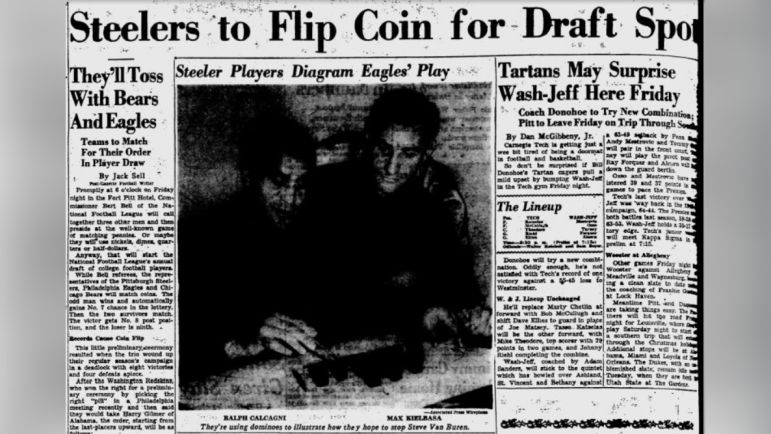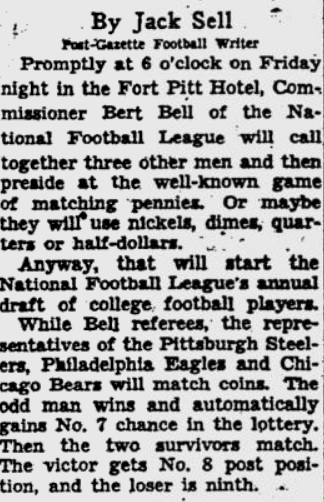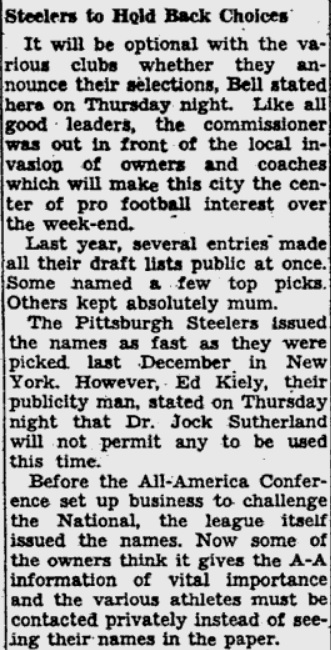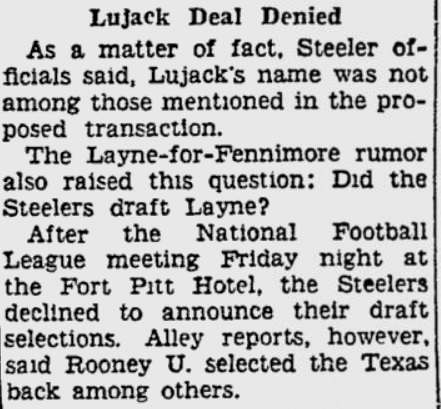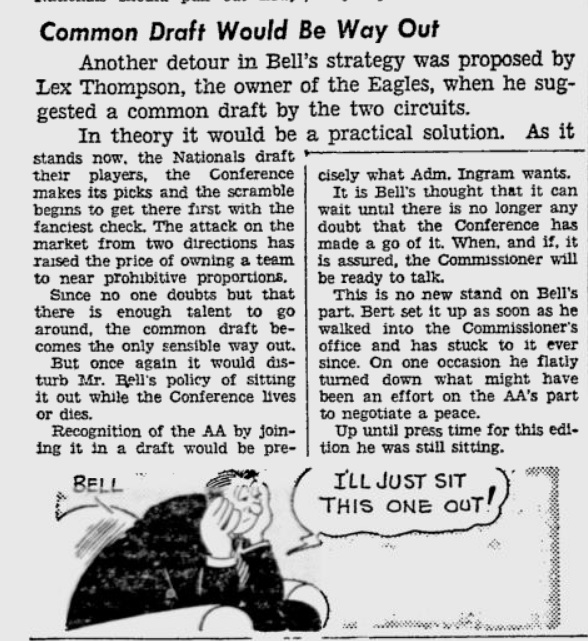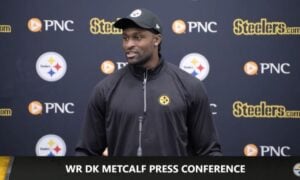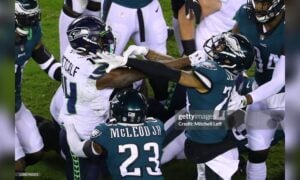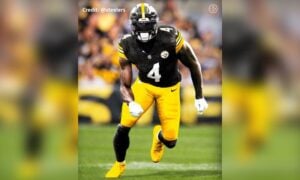Picture it. The 2026 NFL Draft held in downtown Pittsburgh. Football’s biggest offseason event occurring in the heart of the Steel City. But it’s not on television. There’s hardly any buzz. When you check the news the next morning, the draft occurred but the Steelers’ picks aren’t announced. And there’s another league gunning to get whichever players Pittsburgh actually selected. And the NFL season isn’t even over yet.
That’s what the draft was like in 1947, the last and only other time it was held in Pittsburgh. For clarity’s sake, this was the 1948 NFL Draft but not held in its calendar year. It took place on December 19, 1947, at the Fort Pitt Hotel. At the time, the NFL’s draft came after the regular season but before the playoffs. For Pittsburgh, it was the team’s first-ever playoff appearance, though they’d be shut out by the Philadelphia Eagles two days later. Still, the city was buzzing with football.
The Washington Redskins held the No. 1 pick. It wasn’t because they were the NFL’s worst team the year before, the New York Giants and Detroit Lions finished with worse records. At the time, the league implemented a “bonus” system to determine the No. 1 overall pick. Owners would literally select pieces of paper out of Commissioner Bert Bell’s hat. Whoever picked the bonus slip would receive the top pick. Pittsburgh came away with the No. 1 selection in 1956, still the only defensive back to ever be drafted first.
Pittsburgh had a pair of first-round picks in 1947, selecting third and ninth. The third overall pick came via the Detroit Lions in the Bill Dudley trade, while the ninth pick came via coin toss, meaning large parts of the first round were built by random chance. The Chicago Bears, Eagles, and Steelers all flipped coins to determine draft order. The Pittsburgh Post-Gazette notes it was for the seventh, eighth, and ninth selections, but the actual draft order placed the Eagles eighth, Steelers ninth, and Bears tenth. So, the paper of record might have been slightly off.
The Redskins selected Alabama back Harry Gilmer first overall. A multi-time college All-American and two-time Heisman finalist, he went on to have a fine NFL career, making a pair of Pro Bowls. Penn back Skip Minisi was selected second by the Giants. He retired after his rookie season, pursuing a law degree and becoming a successful attorney and intensely connected with the local community outside Philadelphia, praised for his graciousness and public service.
Pittsburgh picked third. Spoiler: they took Texas quarterback Bobby Layne. But at the time, you wouldn’t have known it.
Some backstory. In 1947, there were two separate leagues. The National Football League and the All-America Football Conference, referred to in the papers as the AA. Founded for the 1946 year, the league quickly gained traction with Otto Graham, Paul Brown, Marion Motley, and the powerhouse Cleveland Browns. Because the two leagues were separate, there wasn’t a draft that included both leagues. And instead of the AA attempting to hold a separate draft, they chose to compete directly with the NFL’s pool. Teams like the Steelers may have had rights to their draft picks, but that didn’t protect them from the AA, who could waive checks at players in the hopes they’d defect to their league.
What was one way NFL teams could protect themselves? Tell no one. Except for the player they selected and presumably the league. The Steelers – under new, shrewd, and successful head coach Jock Sutherland, declined to announce their picks to the media.
Rumor was the Steelers selected Layne but no one knew for sure.
The ending to the story? Pittsburgh indeed took Layne, though their time with him was brief. Unwilling to play in the Steelers’ single-wing system, they’d be the last team to adopt the T-formation in 1952, Pittsburgh traded Layne to the Chicago Bears for QB Ray Evans, who threw 17 interceptions in his lone season with the team. Chicago then nearly traded him to the Green Bay Packers while Layne tried to work a trade to the Chicago Cardinals. He was eventually dealt to the New York Bulldogs and then traded to the Detroit Lions. There, he’d become an NFL star. Layne’s career came full circle, traded to the Steelers in 1958. Got all that? It was a different world back then.
Mark down Layne as another quarterback the Steelers let slip through their grasp, joining Johnny Unitas (rostered and cut), Len Dawson (rostered and traded), Sid Luckman (traded rights of), and Dan Marino (passed on in draft).
If you’re wondering about the draft, there already was a push to create a common draft between the AA and the NFL. Eagles’ owner Lex Thompson pushed for it. AA Commissioner Admiral Jonas H. Ingram – who received the Medal of Honor and Purple Heart for wounds in a wolfpack battle against German submarines in 1942 – also endorsed the idea. Such a draft would make the AA’s league legitimate in the eyes of the NFL. But Bell held firm against it, preferring a hands-off approach, essentially a “free market” approach. The Pittsburgh Press chided him for his inaction.
The two leagues would merge in 1949.
Sidebars upon sidebars aside, the rest of the draft chugged along. With the ninth pick, Pittsburgh selected Georgia end Dan Edwards. He’d never play for the Steelers, joining the AA’s Brooklyn Dodgers (again, the leagues competed for players), and the Steelers were left empty-handed. The other notable pick of the first round was the Lions taking QB Y.A. Tittle. He, too, would join the AA’s Baltimore Colts before beginning a Hall of Fame career as part of the San Francisco 49ers’ Million Dollar Backfield.
To recap. The 1948 NFL draft was:
– Held in 1947 before the playoffs began
– The No. 1 pick was selected out of a hat
– Three teams held coin flips to determine the draft order
– Pittsburgh did not disclose their draft picks
– They traded their top pick away
– Their other first-round pick was signed away by the competing league
The league’s come a long way. The 2026 NFL Draft will be attended by hundreds of thousands of fans over the weekend, with Pittsburgh’s mayor boldly predicting one million showing up downtown. There will be glitz and glamour, generating upwards of $200 million for the local economy. Draftniks like us will discuss and debate the picks before and after, while each selection will be scrutinized throughout their career. Some will become the league’s next star. Others, the biggest busts. It won’t resemble anything like the 1948 draft. But without that foundation, the league wouldn’t enjoy the massive success the draft has become today.

